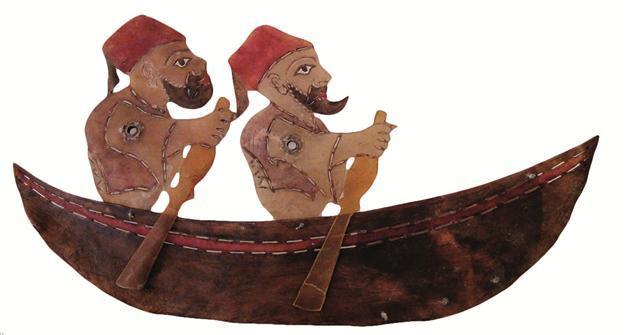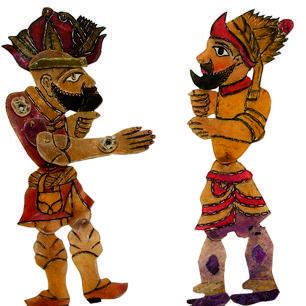Unique Karagöz collection in Germany
COLOGNE – Doğan News Agency

DHA Photos
One of the rarest collections of the traditional Turkish Karagöz-Hacivat shadow play belongs to the University of Cologne in Germany. The rich collection of 150 pieces, which is being kept in a chateau, even includes 200-year-old figures. Among them is a piglet figure, which was printed in Turkey in 1936 and caused the first Karagöz book, written by Rahmi Balaban, to be collected and burned.
It is not exactly known if Karagöz and Hacivat really lived, and if they lived, where and when they lived.
According to a rumor, Karagöz was Sofyozlu Bali Çelebi, the innkeeper of the Byzantine Emperor Constantin. According to another rumor, Karagöz and Hacivat were two glass workmen who were living in Bursa during the time of Orhan Gazi.
Speaking about the unique Karagöz collection, Karagöz artist living in Cologne Ali Köken said the following:
“The figures here were generally made of camel leather. There are also those made of cowhide.
Madder was used in painting. The reason why camel leather was used is that it is tough. Its procession is hard, but it can easily be moved. Also, it is not thin and engrains painting very well. I have previously seen other collections in other German museums and in Bursa. But this is the best collection I have ever seen. The figures here are old, dating back to 200 years ago. There are also ethnic groups, professional groups, regional groups and animal figures. We see examples of palace and public Karagöz artists. Public artist’s depictions are simple, but the palace artists did a very good job. It is very interesting that palace artists’ figures are here. I don’t know how they came here. This collection is a rare source for Karagöz artists.”
 The pig
The pig The first book in the world on the Karagöz shadow play was written by Islamic sciences researcher and Turkologist Dr. Georg Jacob in 1900. The second book was written in 1924 by Islamic Sciences and Middle East researcher Professor Hellmut Ritter. Rahmi Balaban was the first Turk who wrote the first Karagöz book in 1936. But the book, which had the figure of a pig in it, was collected and burned.
The pig figure, which caused the book to be burned, is in this collection. Köken told the story of the book:
“Turks did not write any books on the Karagöz shadow theater until 1936. This tradition was heard through the grapevine. Balaban printed 1,000 books through his own means. The depiction of the pig in the book received many negative reactions. Then the book was collected and burned. Later in 1944, Balaban released a new book, avoiding the pig.”
Colorful and movable
University of Cologne Documentation and Research Center for Theater History and Media Culture Director Professor W. Marx provided information about the creation of the collection, saying, “Karl Niessen collected shadow theater figures from around the world in the 1920s. Nearly 150 pieces of Karagöz figures were made in the end of the 18th century and the beginning of the 19th century.

Ali Köken shows the pig figure, which was printed in
Turkey in 1936 and caused the first Karagöz book to be
burned.
Besides Turkish figures, there are also some from Egypt, China, India and Indonesia in the collection. The difference of Karagöz figures from others is that they are very colorful and movable.”
Theater scientist and deputy director of the center, Dr. Rudi Strauch said they needed financial support for the figures to be documented, renovated and preserved. He said:
“We need to start working to restore and preserve the Karagöz figures. We have applied to receive the necessary support. This process will be carried out by a master of this profession. In this way, the restoration process will not damage the figures. We have connections in Istanbul. Officials there are willing to work with us. We also take advantage of German researchers who carried out research in Turkey in the beginning of the 20th century. Turkish and German researchers have collaborated on this job.”
Enes Türkoğlu, who is studying at the University of Cologne Media and Culture Department, is carrying out work in the university’s documentation and research center. He explained how his interests started in Karagöz and Hacivat:
“Cengiz Özbek, the organizer of the Istanbul Puppet Festival, was a close friend of my mother in my childhood. Topkapı Palace has opened his solo exhibition. When I saw his first figures, I found them very interesting. Then I viewed his shows. My interest increased in Karagöz and now I continue my research to the University of Cologne.”

 The pig
The pig 